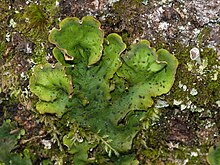Peltigera
| Peltigera | |
|---|---|

| |
| Peltigera leucophlebia | |
| Scientific classification | |
| Domain: | Eukaryota |
| Kingdom: | Fungi |
| Division: | Ascomycota |
| Class: | Lecanoromycetes |
| Order: | Peltigerales |
| Family: | Peltigeraceae |
| Genus: | Peltigera Willd. (1787) |
| Type species | |
| Peltigera canina (L.) Willd. (1787)
| |
| Synonyms[1] | |
| |
Peltigera is a genus of approximately 100 species of foliose lichens in the family Peltigeraceae.[2] Commonly known as the dog or pelt lichens, species of Peltigera are often terricolous (growing on soil), but can also occur on moss, trees, rocks, and many other substrates in many parts of the world.[3]
Most species of Peltigera have the
Description
Species of Peltigera are
Peltigera can be distinguished from the equally large and leaf-like lichen, Nephroma, by its veined lower cortex; Nephroma, by contrast, has a smooth, unveiled lower cortex.[9]
Habitat
Peltigera are mainly ground-dwelling, but can also be found on mosses or dead wood.[9] Some species are used as forest succession indicators.
Taxonomy
In 1753, Linnaeus first described the species Lichen apthosus and L. caninus back when all known lichens were grouped into the genus Lichen.[10] Later, in 1787, Willdenow circumscribed the genus Peltigera, and redescribed P. aphthosa and P. canina.[11]
The generic name is derived from the Latin language pelta (small shield), and refers to the shield-shaped thallus in these species. The common name, the dog lichen, refers to the perceived resemblance of P. caninus to a dog.[12]
Phylogeny
In a comparative analysis of both morphological and chemical characteristics as well as sequences of large subunit nuclear
, have been changed to a group as there appears to be several species clustered under a single name.Distribution
The Peltigera have a widespread distribution, and are found on all continents. There are 34 North American species, 30 European species, 25 species from South America, and 16 species from New Zealand.[3][4][14][15]
Species




- Peltigera aphthosa (L.) Willd. (1787)
- Peltigera aquatica Miądl. & Lendemer (2014)
- Peltigera britannica (Gyeln.) Holt.-Hartw. & Tønsberg (1983)
- Peltigera canina (L.) Willd. (1787)
- Peltigera castanea Goward, Goffinet & Miądl. (2003)
- Peltigera chionophila Goward & Goffinet (2000)
- Peltigera cinnamomea Goward (1995)
- Peltigera collina (Ach.) Schrad. (1801)
- Peltigera degenii Gyeln. (1927)
- Peltigera didactyla (With.) J.R.Laundon (1984)
- Peltigera dilacerata (Gyeln.) Gyeln. (1932)
- Peltigera dolichorhiza (Nyl.) Nyl. (1888)
- Peltigera elisabethae Gyeln. (1927)
- Peltigera evansiana Gyeln. (1931)
- Peltigera extenuata (Nyl. ex Vain.) Lojka (1886)
- Peltigera fibrilloides (Gyeln.) Vitik. (1998)
- Peltigera fimbriata Vitik., Sérus., Goffinet & Miądl. (2009)
- Peltigera frigida R.Sant. (1944)
- Peltigera gowardii Lendemer & H.E.O'Brien (2011)
- Peltigera granulosa Sérus., Goffinet, Miądl. & Vitik. (2009)
- Peltigera horizontalis (Huds.) Baumg. (1790)
- Peltigera hydrophila W.R.Buck, J.Miadlikowska & N.Magain (2020)
- Peltigera hydrothyria Miądl. & Lutzoni (2000)
- Peltigera hymenina (Ach.) Delise (1830)
- Peltigera isidiophora L.F.Han & S.Y.Guo (2015)
- Peltigera islandica T.Goward & S.S.Manoharan-Basil (2016)
- Peltigera koponenii Sérus., Goffinet, Miądl. & Vitik. (2009)
- Peltigera lactucifolia (With.) J.R.Laundon (1984)
- Peltigera lairdii C.W.Dodge & E.D.Rudolph (1955)
- Peltigera latiloba Holt.-Hartw. (2005)
- Peltigera lepidophora (Vain.) Bitter (1904)
- Peltigera leptoderma Nyl. (1860)
- Peltigera leucophlebia (Nyl.) Gyeln. (1926)
- Peltigera malacea (Ach.) Funck (1827)
- Peltigera membranacea (Ach.) Nyl. (1887)
- Peltigera montis-wilhelmii Sérus., Goffinet, Miądl. & Vitik. (2009)
- Peltigera neckeri Hepp ex Müll.Arg. (1862)
- Peltigera neodegenii L.F.Han, S.Y.Guo & X.M.Xu (2018)
- Peltigera neopolydactyla (Gyeln.) Gyeln. (1932)
- Peltigera neorufescens Goward & Manoharan-Basil (2016)
- Peltigera pacifica Vitik. (1985)
- Peltigera papuana Sérus., Goffinet, Miądl. & Vitik. (2009)
- Peltigera phyllidiosa Goffinet & Miądl. (1999)
- Peltigera polydactylon (Neck.) Hoffm. (1789)
- Peltigera ponojensis Gyeln. (1931)
- Peltigera praetextata (Flörke ex Sommerf.) Zopf (1909)
- Peltigera pulverulenta (Taylor) Nyl. (1860)
- Peltigera pusilla (Fr.) Körb. (1855)
- Peltigera retifoveata Vitik. (1985)
- Peltigera rufescens (Weiss) Humb. (1793)
- Peltigera scabrosa Th.Fr. (1860)
- Peltigera scabrosella Holt.-Hartw. (1988)
- Peltigera seneca Magain, Miądl. & Sérus. (2016)
- Peltigera serusiauxii Magain, Miadl., Goffinet & Ant. Simon (2020)
- Peltigera shennongjiana Han & Guo (2016)[16] – China
- Peltigera sorediifera (Nyl.) Vitik. (2008)
- Peltigera subhorizontalis Gyeln. (1932)
- Peltigera tartarea (Llano) Vitik. (2006)
- Peltigera tereziana Gyeln. (1928)
- Peltigera ulcerata Müll.Arg. (1880)
- Peltigera vainioi Gyeln. (1928)
- Peltigera venosa (L.) Hoffm. (1789)
- Peltigera weberi Sérus., Goffinet, Miądl. & Vitik. (2009)
- Peltigera wulingensis L.F.Han & S.Y.Guo (2013)
Uses
Peltigera species have been used historically to treat wounds, urinary disorders,
Food source
Although a few reports have described
Bioactive compounds
References
- Species Fungorum. Retrieved 25 August 2020.
- hdl:10481/61998.
- ^ S2CID 86553148.
- ^ a b Vitikainen O. (1994). (1998). Taxonomic notes on neotropical species of Pelitgera. In: Lichenology in Latin America: history, current knowledge and applications. Edited by M. P. Marcelli, and M.R.D. Seaward. CETESB, Companhia de Tecnologia de Saneamento Ambiental, Estado de Sao Paulo. pp. 135-139.
- ^ Fioliose lichens, Lichen Thallus Types, Allan Silverside
- ISBN 0-87071-394-9.
- S2CID 85011483.
- S2CID 4094256.
- ^ a b "CNALH - Peltigera". lichenportal.org. Retrieved 2021-03-22.
- ^ Linnaeus C. (1753). Species plantarum. Stockholm.
- ^ Willdenow 1787
- ^ ISBN 0-300-08249-5.
- S2CID 21991612. Archived from the original(PDF) on 2020-06-26.
- doi:10.1139/b95-012.
- ^ Galloway DJ (2000). "The lichen genus Peltigera (Peltigerales:Ascomycota) in New Zealand". Tuhinga. 11: 1–45.
- S2CID 214097889.
- ^ Negi HR, Kareem A (1996). "Lichens: the unsung heroes". Amruth. 1 (4): 3–6.
- ISBN 0-88192-453-9.
- S2CID 32376858.
- ^ Vartia KO. (1950). On the medicinal use of lichens. Academic dissertation. Helsinki: 11–21.
- PMID 15752633.
- S2CID 13768322.
- PMID 33863029.
- doi:10.1139/z85-162.
- ^ Kallman S (1992). "Wild plants as food during survival situations". Sven Bot Tidsk. 86 (2): 49–52.
- .
- PMID 12487331.
- .
- PMID 3834834.
- JSTOR 3244359.
Further reading
Gilbert, O. Lichens Naturally Scottish. 2004. Scottish Natural Heritage.
